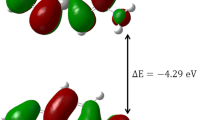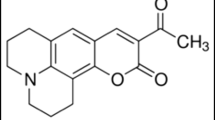Abstract
In this research, the ground (µg) and excited (µe) state dipole moments of metformin hydrochlorides were determined using Lippert-Mataga, Bakhshiev's, Kawski-Chamma-Viallet, and Reichardt models from fluorescence emission and UV-Vis absorption spectra in various solvents. From solvatochromic effects the calculated excited (µe ) dipole moment of metformin hydrochloride were, 8.55 D, 8.34 D, 6.08 D, and 6.40 D using the Lippert-Mataga, Bakhshiev's, Kawski-Chamma-Viallet and Reichardt models respectively. The results also indicated that the dipole moment at the ground state is smaller than the excited state. This is due to solvent polarity having a stronger effect on fluorescence emission than absorption spectra. Similarly, from density functional theory, the calculated ground and excited states dipole moments of metformin hydrochloride using (DFT-B3LYP- 3-21+G*(μg = 10.02 D and μe = 11.94 D), DFT-B3LYP- 6-31+G (d, p) (μg = 8.44 D and μe = 10.87 D), and DFT-B3LYP- 6-311+G (d, p) (μg = 8.24 D and μe = 18.74 D)) analyzed by Gaussian 09W. From the optimized geometry of the molecule, the HOMO-LUMO energy band gap of metformin hydrochloride were computed using DFT [DFT-B3LYP- 3-21+G*(5.51 eV), DFT-B3LYP- 6-31+G (d, p) (5.66 eV), and DFT-B3LYP- 6-311+G (d, p) (5.70 eV)] respectively.










Similar content being viewed by others
Data Availability
All datasets generated in this study can be recovered from information accessible inside the article
References
Xiong W et al (2021) Metformin liposome-mediated PD-L1 downregulation for amplifying the photodynamic immunotherapy efficacy. ACS Appl Mater Interfaces 13:8026–8041. https://doi.org/10.1021/acsami.0c21743
Polyakova EB, Sabirzyanov DR, Prozorova NA, Foteeva AB (2022) Physicochemical Properties and Methods for the determination of Metformin Hydrochloride (A Review). Pharm Chem J 55(10):1119–1125. https://doi.org/10.1007/s11094-021-02546-2
Szekalska M, Sosnowska K, Zakrzeska A, Kasacka I, Lewandowska A, Winnicka K (2017) The influence of chitosan cross-linking on the properties of alginate microparticles with metformin hydrochloride - in vitro and in vivo evaluation. Molecules 22(1):182. https://doi.org/10.3390/molecules22010182
Saini N, Yang X (2018) Metformin as an anti-cancer agent: actions and mechanisms targeting cancer stem cells. Acta Biochim Biophys Sin (Shanghai) 50(2):133–143. https://doi.org/10.1093/abbs/gmx106
Ahn HK, Lee YH, Koo KC (2020) Current status and application of metformin for prostate cancer: a comprehensive review. Int J Mol Sci 21(22):1–18. https://doi.org/10.3390/ijms21228540
Podhorecka M (2021) Metformin - its anti-cancer effects in hematologic malignancies. Oncol Rev 15(1). https://doi.org/10.4081/oncol.2021.514
Bai B, Chen H (2021) Metformin: a Novel Weapon against inflammation. Front Pharmacol 12:1–12. https://doi.org/10.3389/fphar.2021.622262
Kristófi R, Eriksson JW (2021) Metformin as an anti-inflammatory agent: A short review. J. Endocrinol 251(2):R11–R22. https://doi.org/10.1530/JOE-21-0194
Wang JC et al (2018) Metformin’s antitumour and anti-angiogenic activities are mediated by skewing macrophage polarization. J Cell Mol Med 22(8):3825–3836. https://doi.org/10.1111/jcmm.13655
Ma R, Yi B, Riker AI, Xi Y (2020) Metformin and cancer immunity. Acta Pharmacol Sin 41(11):1403–1409. https://doi.org/10.1038/s41401-020-00508-0
Soukas AA, Hao H, Wu L (2019) Metformin as Anti-Aging Therapy: is it for everyone? Trends Endocrinol Metab 30(10):745–755. https://doi.org/10.1016/j.tem.2019.07.015
Yu C et al (2022) Determination and correlation of solubility of Metformin Hydrochloride in Aqueous Binary solvents from 283.15 to 323.15 K. ACS Omega 7(10):8591–8600. https://doi.org/10.1021/acsomega.1c06468
Foretz M, Guigas B, Bertrand L, Pollak M, Viollet B (2014) Metformin: from mechanisms of action to therapies. Cell Metab 20:953–966. https://doi.org/10.1016/j.cmet.2014.09.018
Woldegiorges K, Belay A, Kebede A, Abebe T (2021) Estimating the ground and excited state dipole moments of levofloxacin and norfloxacin drugs using Solvatochromic Effects and computational work. J Spectrosc 2021:1. https://doi.org/10.1155/2021/7214182
Madar M (2022) Effect of D- π -A substituted bromomethylcoumarin derivatives on Optoelectronic Properties: experimental and computational studies. 1–20
Muddapur GV, Patil NR, Patil SS, Melavanki RM, Kusanur RA (2014) Estimation of ground and excited state dipole moments of aryl boronic acid derivative by solvatochromic shift method. J Fluoresc 24(6):1651–1659. https://doi.org/10.1007/s10895-014-1452-6
Paper O (2015). Time-dependent density functional theory calculations of the solvatochromism of some azo sulfonamide fluorochromes. https://doi.org/10.1007/s00894-015-2651-z
Belay A, Libnedengel E, Kim HK, Hwang YH (2016) Effects of solvent polarity on the absorption and fluorescence spectra of chlorogenic acid and caffeic acid compounds: determination of the dipole moments. Luminescence 31(1):118–126. https://doi.org/10.1002/bio.2932
Raab MT, Prýmek AK, Giordano AN (2021) Estimation of the ground and excited state dipole moments for ibuprofen and naproxen sodium using the solvatochromic shift method
Thiaré DD et al (2015) Determination of ground and excited state dipole moments of amino-benzimidazole by solvatochromic shift methods and theoretical calculations. J Mol Liq 211:640–646. https://doi.org/10.1016/j.molliq.2015.07.071
Sıdır YG (2015) Part “Spectrochimica a molecular and biomolecular spectroscopy estimation of ground and excited state dipole moments of Oil Red O by solvatochromic shift methods. 135:560–567. https://doi.org/10.1016/j.saa.2014.07.049
Tiwari K, Arora P, Pandey N, Pandey P, Joshi HC, Pant S (2014) Experimental and computational approaches on dipole moment of 5-aminoisoquinoline. J. Mol. Liq 200, no. PB:460–464. https://doi.org/10.1016/j.molliq.2014.10.027
Wilke J, Wilke M, Meerts WL, Schmitt M (2016) Determination of ground and excited state dipole moments via electronic Stark spectroscopy: 5-methoxyindole. J Chem Phys 144(4):044201. https://doi.org/10.1063/1.4940689
Lippert E (1955) Dipolmoment und Elektronenstruktur von angeregten Molekülen. Z fur Naturforsch - Sect J Phys Sci 10(7):541–545. https://doi.org/10.1515/zna-1955-0707
Bakhshiev NG (1964) Universal Intermolecular interactions and their effect on the position of the Electronic Spectra of Molecules in two-component solutions. VII. Theory (General Case of an isotropic solution). Opt Spectrosc 16:446
Chamma A, Viallet P (1970) Determination du moment dipolaire d’une molecule dans un etat excite singulet. CR Acad Sci Paris Ser C 270:1901–1904
Ravi M, Soujanya T, Samanta A, Radhakrishnan TP (1995) Excited-state dipole moments of some coumarin dyes from a solvatochromic method using the solvent polarity parameter, E. J Chem Soc Faraday Trans 91(17):2739–2742. https://doi.org/10.1039/FT9959102739
Reichardt C (1994) Solvatochromic dyes as solvent polarity indicators. Chem Rev 94(8):2319–2358. https://doi.org/10.1021/cr00032a005
Sidir YG (2020) The solvatochromism, electronic structure, electric dipole moments and DFT calculations of benzoic acid liquid crystals. Liq Cryst 47(10):1435–1451. https://doi.org/10.1080/02678292.2020.1733685
Bozkurt E, Gül HI, Tuǧrak M (2017) Investigation of solvent effect on photophysical properties of some sulfonamides derivatives. Turkish J Chem 41(2):282–293. https://doi.org/10.3906/kim-1604-61
Shkoor M, Mehanna H, Shabana A, Farhat T, Bani-Yaseen AD (2020) Experimental and DFT/TD-DFT computational investigations of the solvent effect on the spectral properties of nitro substituted pyridino[3,4-c]coumarins. J Mol Liq 313:113509. https://doi.org/10.1016/j.molliq.2020.113509
Airinei A, Isac DL, Homocianu M, Cojocaru C, Hulubei C (2017) Solvatochromic analysis and DFT computational study of an azomaleimide derivative. J Mol Liq 240:476–485. https://doi.org/10.1016/j.molliq.2017.05.096
Manohara SR, Kumar VU, Shivakumaraiah, Gerward L (2013) Estimation of ground and excited-state dipole moments of 1, 2-diazines by solvatochromic method and quantum-chemical calculation. J Mol Liq 181:97–104. https://doi.org/10.1016/j.molliq.2013.02.018
Krawczyk P, Bratkowska M, Wybranowski T, Hołyńska-Iwan I, Cysewski P, Jędrzejewska B (2020) Experimental and theoretical insight into spectroscopic properties and bioactivity of 4-(4-formylbenzylidene)-2-phenyloxazol-5(4H)-one dye for future applications in biochemistry. J Mol Liq 314:113632. https://doi.org/10.1016/j.molliq.2020.113632
Patil V, Padalkar VS, Sekar N, Patil SV, Rajput J (2019) Synthesis of 2-methyl-5-(5-phenyl substituted-1,3,4 oxadiazole-2-yl) quinazolin-4-one fluorescent brightening agent: computational and experimental comparison of photophysical structure. J Mol Struct 1182:150–157. https://doi.org/10.1016/j.molstruc.2019.01.039
Painagoni KM, Patil HD (2013) “Estimation of Ground and Excited State Dipole Moments of Some Laser Dyes,” J. Eng. Res. Appl. www.ijera.com, vol. 3, pp. 641–647, Accessed: Oct. 09, 2021. [Online]. Available: www.ijera.com
Gülseven Sidir Y, Sidir I (2013) Solvent effect on the absorption and fluorescence spectra of 7-acetoxy-6-(2,3-dibromopropyl)-4,8-dimethylcoumarin: determination of ground and excited state dipole moments. Spectrochim Acta - Part A Mol Biomol Spectrosc 102:286–296. https://doi.org/10.1016/j.saa.2012.10.018
Patil MK, Kotresh MG, Inamdar SR (2019) A combined solvatochromic shift and TDDFT study probing solute-solvent interactions of blue fluorescent Alexa Fluor 350 dye: evaluation of ground and excited state dipole moments. Spectrochim Acta - Part A Mol Biomol Spectrosc 215:142–152. https://doi.org/10.1016/j.saa.2019.02.022
Acknowledgments
The authors acknowledge Adama Science and Technology University for its support during this research work.
Author information
Authors and Affiliations
Contributions
Semahegn Asemare: Conceptualization, Analysis, Writing & editing, Writing original draft of manuscript. Abebe Belay: Conceptualization, give resources, Supervision, Reviewing & editing manuscript. Alemu Kebede: Supervision, Reviewing & editing manuscript. Umer Sherfedin: Reviewing & editing manuscript.
Corresponding authors
Ethics declarations
Ethical Approval
Not applicable as the study does not include any use of animals and humans.
Conflict of Interest
The authors declare that there is no conflict of interest.
Additional information
Publisher's Note
Springer Nature remains neutral with regard to jurisdictional claims in published maps and institutional affiliations.
Rights and permissions
Springer Nature or its licensor (e.g. a society or other partner) holds exclusive rights to this article under a publishing agreement with the author(s) or other rightsholder(s); author self-archiving of the accepted manuscript version of this article is solely governed by the terms of such publishing agreement and applicable law.
About this article
Cite this article
Asemare, S., Belay, A., Kebede, A. et al. Ground and Excited State Dipole Moments of Metformin Hydrochloride using Solvatochromic Effects and Density Functional Theory. J Fluoresc 34, 1207–1217 (2024). https://doi.org/10.1007/s10895-023-03355-4
Received:
Accepted:
Published:
Issue Date:
DOI: https://doi.org/10.1007/s10895-023-03355-4




